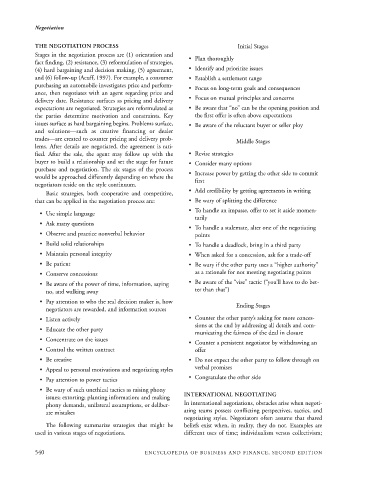Page 563 - Encyclopedia of Business and Finance
P. 563
eobf_N 7/5/06 3:16 PM Page 540
Negotiation
THE NEGOTIATION PROCESS Initial Stages
Stages in the negotiation process are (1) orientation and
• Plan thoroughly
fact finding, (2) resistance, (3) reformulation of strategies,
(4) hard bargaining and decision making, (5) agreement, • Identify and prioritize issues
and (6) follow-up (Acuff, 1997). For example, a consumer • Establish a settlement range
purchasing an automobile investigates price and perform- • Focus on long-term goals and consequences
ance, then negotiates with an agent regarding price and
• Focus on mutual principles and concerns
delivery date. Resistance surfaces as pricing and delivery
expectations are negotiated. Strategies are reformulated as • Be aware that “no” can be the opening position and
the parties determine motivation and constraints. Key the first offer is often above expectations
issues surface as hard bargaining begins. Problems surface, • Be aware of the reluctant buyer or seller ploy
and solutions—such as creative financing or dealer
trades—are created to counter pricing and delivery prob-
Middle Stages
lems. After details are negotiated, the agreement is rati-
fied. After the sale, the agent may follow up with the • Revise strategies
buyer to build a relationship and set the stage for future • Consider many options
purchase and negotiation. The six stages of the process
• Increase power by getting the other side to commit
would be approached differently depending on where the
first
negotiators reside on the style continuum.
• Add credibility by getting agreements in writing
Basic strategies, both cooperative and competitive,
that can be applied in the negotiation process are: • Be wary of splitting the difference
• To handle an impasse, offer to set it aside momen-
• Use simple language
tarily
• Ask many questions
• To handle a stalemate, alter one of the negotiating
• Observe and practice nonverbal behavior points
• Build solid relationships • To handle a deadlock, bring in a third party
• Maintain personal integrity • When asked for a concession, ask for a trade-off
• Be patient • Be wary if the other party uses a “higher authority”
• Conserve concessions as a rationale for not meeting negotiating points
• Be aware of the power of time, information, saying • Be aware of the “vise” tactic (“you’ll have to do bet-
no, and walking away ter than that”)
• Pay attention to who the real decision maker is, how
Ending Stages
negotiators are rewarded, and information sources
• Listen actively • Counter the other party’s asking for more conces-
sions at the end by addressing all details and com-
• Educate the other party
municating the fairness of the deal in closure
• Concentrate on the issues
• Counter a persistent negotiator by withdrawing an
• Control the written contract offer
• Be creative • Do not expect the other party to follow through on
verbal promises
• Appeal to personal motivations and negotiating styles
• Pay attention to power tactics • Congratulate the other side
• Be wary of such unethical tactics as raising phony
INTERNATIONAL NEGOTIATING
issues; extorting; planting information; and making
phony demands, unilateral assumptions, or deliber- In international negotiations, obstacles arise when negoti-
ating teams possess conflicting perspectives, tactics, and
ate mistakes
negotiating styles. Negotiators often assume that shared
The following summarize strategies that might be beliefs exist when, in reality, they do not. Examples are
used in various stages of negotiations. different uses of time; individualism versus collectivism;
540 ENCYCLOPEDIA OF BUSINESS AND FINANCE, SECOND EDITION

